For decades, night-time security footage was synonymous with grainy, indistinct black-and-white images. While these systems provided basic detection, they often failed at the most critical task: identification. Trying to distinguish a face, a license plate, or a specific detail in a low-resolution, blurry image was often an exercise in futility.
Enter the 4k night vision camera. This technology marks a monumental leap forward in surveillance capabilities, merging the ultra-high resolution of 4K (eight million pixels) with sophisticated low-light imaging techniques. The result is a security solution that doesn’t just record activity in the dark—it captures forensic-quality detail, fundamentally changing the landscape of residential and commercial security.
If you are considering upgrading your security infrastructure, understanding the mechanics, benefits, and practical applications of these powerful devices is essential. This comprehensive guide delves into why the 4K standard is non-negotiable for serious security and what features define the best 4k security camera wireless setup for your needs.
Contents
- 1 The Evolution of Night Surveillance: Why 4K Matters
- 2 Decoding the Technology: How 4K Night Vision Cameras Work
- 3 Key Features to Look for in a Modern 4K Night Vision Camera System
- 4 Practical Applications: Where 4K Clarity Shines Brightest
- 5 Installation and Setup: Maximizing Your 4K Investment
- 6 Common Misconceptions and Troubleshooting
- 7 Future Trends in Night Vision Technology
- 8 The Clear Choice for Modern Security
The Evolution of Night Surveillance: Why 4K Matters
Security cameras have followed a similar trajectory to consumer electronics, rapidly accelerating in resolution. However, in the realm of security, resolution is not merely a luxury; it is a necessity directly tied to the system’s effectiveness.
Moving Beyond Analog: The Shift to High Definition
The early generations of security cameras relied on analog signals, offering resolutions that were generally equivalent to 480p or lower. The introduction of 1080p (Full HD) was revolutionary, providing significantly sharper images. Yet, even 1080p systems face limitations when used to monitor large areas, requiring digital zoom that quickly results in pixelation.
4K resolution, officially 3840 x 2160 pixels, boasts four times the pixel count of 1080p. This immense density means that when you digitally zoom in on a suspect or an object captured by a 4k night vision camera, you retain far more actionable detail. This capacity for “digital zoom without degradation” is the core value proposition of 4K security.
The Definition of 4K: Pixels and Precision
In daylight, the benefits of 4K are clear: vibrant colors and crisp lines. But at night, the increased pixel count performs an even more vital function. When light is scarce, every single photon collected by the sensor becomes crucial. Having four times the sensor area (or at least four times the pixel density) allows the system’s processor to gather more data points, resulting in a cleaner, less noisy image.
Furthermore, precision in 4K directly addresses the “Identification Challenge.” Law enforcement and security professionals rely on distinct features—tattoos, clothing logos, facial characteristics—to identify individuals. A low-resolution night image might show a person, but a 4k night vision camera provides the necessary data to secure a positive identification, which is often the difference between a successful investigation and a dead end.
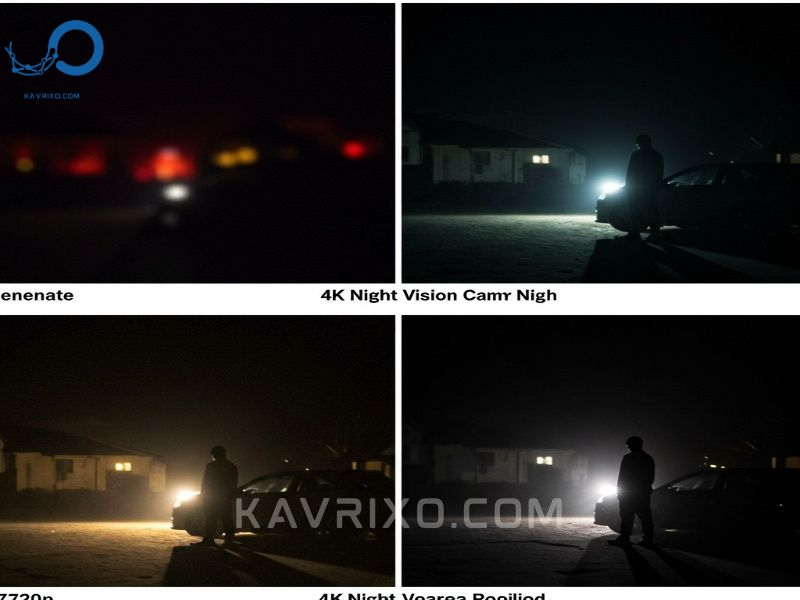
Read more: The Definitive Guide to Choosing a 4K Camera System for Home with NVR System
Decoding the Technology: How 4K Night Vision Cameras Work
Achieving brilliant clarity in pitch-black conditions requires more than just high pixel counts; it demands sophisticated sensor technology and advanced illumination methods. A high-quality 4k night vision camera seamlessly integrates these components.
The Sensor Advantage: CMOS vs. CCD in Low Light
Modern security cameras overwhelmingly utilize CMOS (Complementary Metal-Oxide Semiconductor) sensors. While CCD sensors were once dominant, CMOS technology has evolved to offer superior performance, especially in low light.
Key technological advancements in CMOS sensors that benefit night vision include:
- Backside Illumination (BSI): Traditional sensors have wiring that partially blocks incoming light. BSI technology moves this circuitry to the back, allowing light to hit the photosensitive layer directly. This increases light collection efficiency dramatically, vital for a 4k night vision camera where light is scarce.
- Larger Apertures: While the 4K resolution packs more pixels, the lens and sensor design must work together to capture sufficient light. Cameras designed for superior night vision often feature lenses with very wide apertures (low f-stop numbers), allowing maximum light transmission to the sensor.
The Role of Infrared (IR) Illumination
For environments with zero ambient light, infrared (IR) LEDs are the backbone of traditional night vision. These LEDs emit light in the infrared spectrum (typically 850nm or 940nm), which is invisible to the human eye but easily detectable by the camera’s sensor.
When selecting a system, the IR range and quality are critical:
- IR Range: Measured in feet or meters, this dictates how far the camera can “see” effectively in total darkness. A powerful 4k night vision camera intended for large properties might have an IR range exceeding 100 feet.
- Smart IR: Basic IR can cause “hot spots” where objects close to the camera are overexposed and washed out. Smart IR dynamically adjusts the intensity of the infrared light based on the distance of the objects in the frame, ensuring consistent exposure and clear identification.
Advanced Techniques: Color Night Vision and Starlight Sensors
While traditional IR offers excellent black-and-white detail, black and white footage loses the crucial context provided by color—details like the color of a jacket, car, or hair. This is where advanced low-light technology comes into play, often marketed as “Color Night Vision” or “Starlight.”
Starlight technology utilizes highly sensitive sensors and advanced image processing to amplify even minute levels of ambient light (from streetlights, the moon, or distant windows) to produce a full-color image, long after conventional cameras have switched to black and white IR mode.
A premium 4k night vision camera equipped with Starlight technology can maintain color fidelity in conditions as low as 0.001 lux. This feature dramatically increases the forensic value of the footage, making it a critical differentiator when choosing the best 4k security camera wireless system available today.
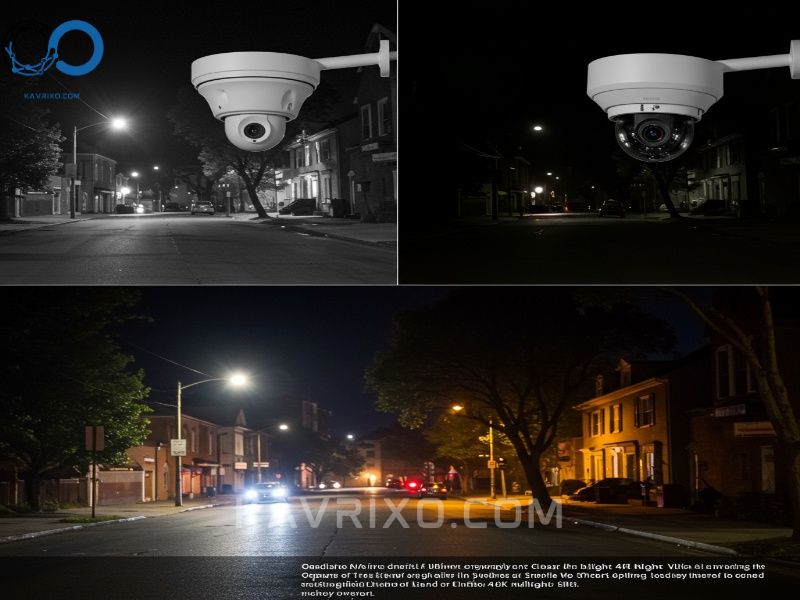
Key Features to Look for in a Modern 4K Night Vision Camera System
The camera’s ability to capture detail at night is only one part of the equation. A truly effective security system must also be reliable, durable, and highly accessible.
Connectivity: Choosing the Best 4K Security Camera Wireless Options
The convenience and flexibility of wireless systems have made them highly popular, particularly for residential and small business installations. However, 4K resolution generates massive amounts of data, which poses a significant challenge for wireless transmission.
When evaluating the best 4k security camera wireless setup, consider the following connectivity factors:
- Bandwidth Requirements: 4K video requires substantial bandwidth. Ensure your wireless system utilizes robust Wi-Fi standards (like Wi-Fi 6) or proprietary wireless protocols designed to handle high throughput without excessive compression or dropping frames.
- Power Management: True wire-free cameras (battery-powered) are incredibly easy to install but often make compromises on night vision capability or recording duration to conserve power. AC-powered wireless cameras (which still require a power cord but transmit data wirelessly) offer consistent 24/7 4K recording and reliable night performance.
- Range and Mesh Networking: For larger properties, look for systems that support mesh networking or have powerful antennae to maintain a stable connection between the cameras and the base station/NVR (Network Video Recorder). A dropped signal renders even the most advanced 4k night vision camera useless.
Durability and Weatherproofing (IP Ratings)
Security cameras are often exposed to the harshest elements. Their longevity and performance depend heavily on their build quality and resistance to environmental factors.
- IP Rating: The Ingress Protection (IP) rating is crucial. For outdoor use, look for an IP66 rating (dust-tight and protected against powerful water jets) or, ideally, an IP67 rating (protected against immersion). This ensures that heavy rain, snow, or dust storms will not compromise the sophisticated electronics of the 4k night vision camera.
- Temperature Extremes: Ensure the camera is rated for the operating temperatures of your specific climate. Security cameras in areas with extreme heat or cold need specialized housing and internal heating/cooling elements to prevent component failure.
- Vandal Resistance (IK Rating): For cameras mounted in accessible locations, an IK rating (Impact Protection) measures resistance to external mechanical impacts. An IK10 rating is the highest standard, indicating excellent resistance to physical abuse.
Field of View and Focal Length Considerations
The field of view (FoV) determines how much area the camera captures. While 4K resolution allows for wider coverage, the lens choice remains vital.
- Fixed Lens: These are standard and cost-effective, offering a set FoV (e.g., 90 degrees). If you know the exact area you need to cover, a fixed lens 4k night vision camera is ideal.
- Vari-focal/Motorized Zoom Lens: These lenses allow the user to remotely adjust the focal length and zoom level. This is invaluable for dynamic surveillance, allowing you to capture a wide panorama and then quickly zoom in to focus on a gate or doorway while maintaining 4K clarity, even at night. This flexibility is a hallmark of professional-grade systems.
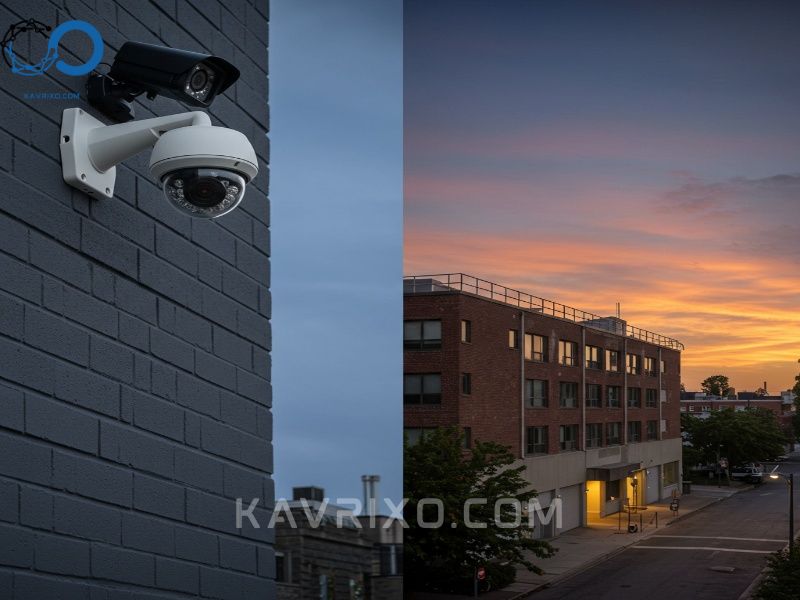
Practical Applications: Where 4K Clarity Shines Brightest
The superior detail provided by a 4k night vision camera translates directly into heightened security across various environments.
Residential Security: Deterrence and Identification
For homeowners, the primary goal of security is deterrence and, failing that, undeniable evidence.
In residential settings, 4K cameras excel in two specific scenarios at night:
- Perimeter Monitoring: Monitoring property lines, driveways, and gates. The wide field of view and high resolution allow a single camera to replace multiple lower-resolution units, effectively reducing blind spots. When integrated with a best 4k security camera wireless setup, installation is discreet and flexible.
- License Plate Capture (LPC): Standard cameras often fail to capture license plates clearly, especially at night when headlights create glare. High-quality 4K cameras, often using specialized lenses and WDR (Wide Dynamic Range) technology, can cut through this glare to capture the necessary alphanumeric details, a critical piece of evidence in theft or hit-and-run incidents.
Commercial and Industrial Monitoring
In large commercial environments—warehouses, parking lots, and construction sites—the coverage area is vast, making high resolution mandatory.
- Inventory Security: In a dimly lit warehouse, 4K allows security teams to zoom into racking aisles to verify inventory status or track movement, a task impossible with blurry, low-resolution infrared footage.
- Liability Reduction: Monitoring loading docks and high-traffic areas at night requires irrefutable evidence in case of accidents or disputes. A 4k night vision camera provides the necessary detail to confirm exact events, minimizing corporate liability.
Specialized Use Cases (Wildlife, Remote Locations)
Beyond standard security, the sensitivity of modern 4K night vision technology lends itself to specialized monitoring. Researchers and land owners utilize these cameras to monitor nocturnal wildlife activity without the need for bright, disruptive visible light. Furthermore, in remote locations powered by solar or limited battery sources, highly efficient 4K systems paired with local NVR storage ensure that valuable, high-definition data is captured reliably, even when connectivity is intermittent.

Installation and Setup: Maximizing Your 4K Investment
Purchasing a top-tier 4k night vision camera is only the first step. Proper installation and configuration are essential to leverage its full potential, particularly regarding night-time performance.
Placement Strategies for Optimal Night Coverage
The primary enemy of night vision is reflected light and obstacles.
- Avoid Reflective Surfaces: Do not aim the camera directly at windows, white walls, or large metallic objects close to the lens. The IR light will bounce back, blinding the camera and washing out the rest of the image.
- Mind the Eaves: Mounting the camera too high under deep eaves can cause the ceiling structure to block the upper portion of the IR illumination pattern, creating a dark crescent in the top of the frame.
- Eliminate Environmental Interference: Spiderwebs and insects are highly reflective under IR light and can instantly trigger motion alerts or obscure the view entirely. Regular maintenance and, in some cases, specialized anti-spider treatments near the camera housing are necessary.
Power Management for Wireless Systems
For the best 4k security camera wireless experience, power reliability is key. As mentioned, true wire-free (battery) 4K cameras are rare because 4K processing consumes substantial power. When choosing a battery model, understand the compromises: they often only record 4K clips when motion is detected and remain in a low-power state otherwise.
If continuous 24/7 recording is required, a PoE (Power over Ethernet) system or an AC-powered wireless system is necessary. PoE is often preferred because a single Ethernet cable handles both data transmission and power, simplifying wiring compared to running separate power and data cables, while guaranteeing the robust bandwidth needed for high-resolution night footage.
Integration with Smart Home Ecosystems
Modern security is defined by integration. The most sophisticated 4k night vision camera systems integrate seamlessly with smart assistants (Alexa, Google Home) and home automation platforms (HomeKit, Zigbee).
This integration allows for:
- Voice Control: “Show me the driveway camera” on a smart display.
- Automated Lighting: If the camera detects motion at night, it can automatically trigger floodlights or internal lights, enhancing both the camera’s color night vision capabilities and increasing deterrence.
- Unified Alerts: Receiving unified notifications across all devices, ensuring immediate action can be taken based on high-resolution evidence.
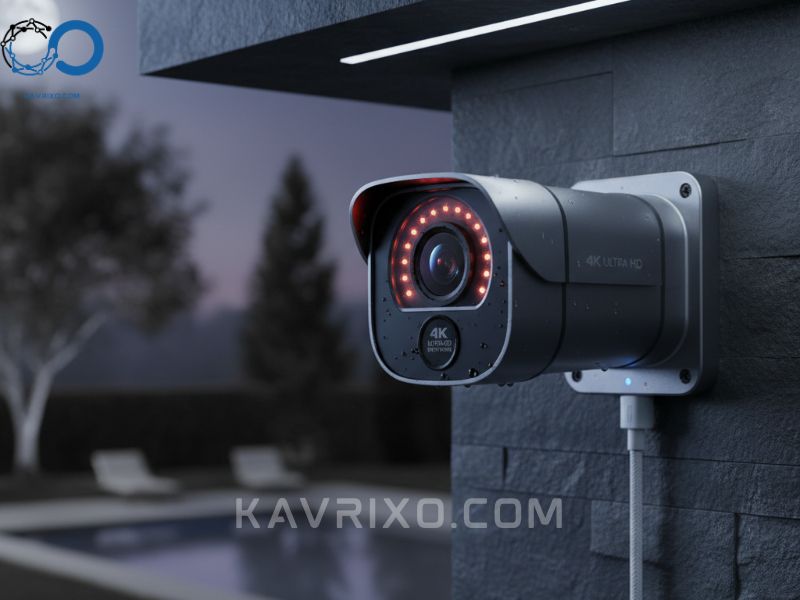
Common Misconceptions and Troubleshooting
While the promise of perfect 4K night vision is exciting, users must manage expectations and understand the technical hurdles involved.
Understanding Compression (H.265+) and Storage Needs
Uncompressed 4K video generates colossal file sizes. A single hour of uncompressed 4K footage can exceed 100 GB. To make 4K surveillance feasible, advanced compression standards are used.
- H.265 (HEVC): This is the current standard, offering significant improvements over the older H.264, reducing file size by up to 50% without a noticeable loss in visual quality.
- H.265+: Many manufacturers offer proprietary enhancements (like H.265+) that optimize compression further, particularly for static security footage where backgrounds don’t change often.
Even with compression, a high-resolution 4k night vision camera system requires substantial storage (large capacity hard drives in the NVR or generous cloud subscription plans). Failing to adequately plan for storage will lead to the system overwriting footage too quickly, potentially losing critical evidence.
Dealing with Environmental Interference (Light Pollution, Spiderwebs)
A frequently encountered issue with IR night vision is poor performance due to environmental factors.
If your night vision is suddenly blurry or obscured, check for:
- Spiderwebs: As mentioned, they are highly reflective. Regular cleaning is mandatory.
- Street Light Contention: If the camera is facing a powerful street lamp, the light source can trick the sensor into thinking the scene is brighter than it is, causing the camera to underexpose the surrounding darkness. Careful aiming, or utilizing cameras with excellent WDR, can mitigate this issue.
- Lens Smudging: Dust, dirt, or water streaks on the lens can severely degrade the 4K clarity, especially at night. Cleaning the lens with a microfiber cloth should be part of routine maintenance.
Future Trends in Night Vision Technology
The field of security imaging is constantly evolving, promising even more robust and intelligent night-time monitoring systems.
AI Integration and Predictive Analytics
The future of the 4k night vision camera lies not just in better images, but in smarter interpretation of those images. AI-powered analytics are becoming standard, enabling:
- Object Classification: Distinguishing between people, vehicles, and animals, drastically reducing false alarms.
- Behavioral Analysis: Detecting abnormal behavior, such as loitering, package dropping, or movement in restricted zones.
- Deep Learning Night Enhancement: AI algorithms are being trained to “denoise” and sharpen low-light 4K images in real-time better than traditional digital signal processing (DSP) chips, further maximizing the detail captured by the sensor.
Enhanced Thermal Imaging Capabilities
While IR and Starlight technology rely on ambient or emitted light, thermal cameras detect heat signatures. Currently, thermal 4K cameras are prohibitively expensive for consumer use, but the technology is steadily becoming more accessible.
The combination of 4K optical clarity and thermal detection offers the ultimate security solution: the thermal sensor detects the presence of a person or animal (even through smoke or fog), and the high-resolution 4k night vision camera provides the forensic detail needed for identification. This dual-sensor approach represents the peak of future-proof security infrastructure, particularly for those seeking the best 4k security camera wireless system for maximum environmental coverage.
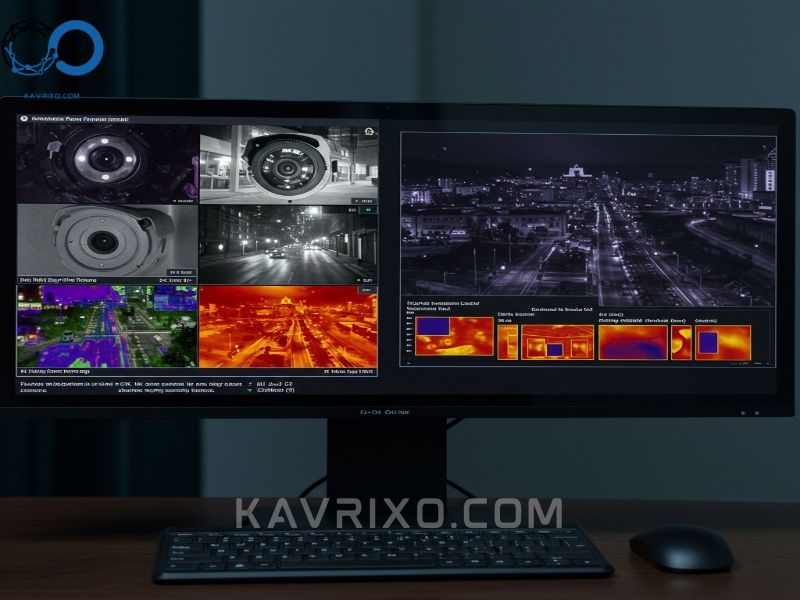
The Clear Choice for Modern Security
The need for highly detailed, actionable surveillance footage has never been greater. The days of accepting blurry, indistinct security video are over. By combining massive pixel density with cutting-edge sensor and illumination technologies, the 4k night vision camera delivers clear, forensic-quality evidence 24 hours a day.
Whether you are securing a small residence or monitoring a sprawling commercial property, investing in a high-quality 4K system—especially the best 4k security camera wireless options that offer Starlight technology and robust connectivity—ensures that when an incident occurs under the cover of darkness, you will have the clarity and detail required to identify, prosecute, and protect. The difference between a low-resolution ghost and a high-resolution identification is the difference between a system that merely records and a system that truly secures.

Pingback: The Definitive Guide to Reolink Cameras: Are Reolink Cameras Good for Modern Security Needs? - Kavrixo Blog